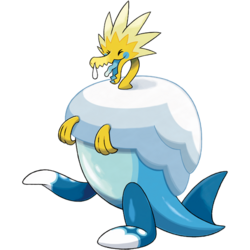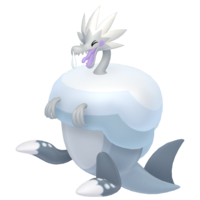From Bulbapedia, the community-driven Pokémon encyclopedia.
Arctozolt (Japanese: パッチルドン Patchilldon) is a dual-type Electric/Ice Fossil Pokémon introduced in Generation VIII.
It is resurrected from combining a Fossilized Bird and Fossilized Dino, and it is not known to evolve into or from any other Pokémon, but it appears to be related to Dracozolt and Arctovish.
Biology
Arctozolt is a hybrid fossil Pokémon. It has a light-blue body with a snow-like patch on the top. Its body has blue fins with white patches on the ends and some spots. It has a plesiosaur-like tail with a fin on top. It has two yellow hands. Arctozolt has a paravian-like head with closed eyes and a blue spot on each cheek. It produces mucus from its nose.
By shaking its freezing upper half, Arctozolt can generate electricity. It was known to live on ancient shores and preserved its food with the ice on its body. It allegedly went extinct because it moved very slowly, but this is likely not the case due to Arctozolt being combined from two separate Pokémon that each had their niches before going extinct.
Game data
Pokédex entries
| This Pokémon was unavailable prior to Generation VIII.
|
| Generation VIII
|
|
Galar
#375
|
|
Sinnoh
#—
|
|
Hisui
#—
|
| This Pokémon has no Pokédex entries in Brilliant Diamond, Shining Pearl, and Legends: Arceus.
|
| Sword
|
The shaking of its freezing upper half is what generates its electricity. It has a hard time walking around.
|
| Shield
|
This Pokémon lived on prehistoric seashores and was able to preserve food with the ice on its body. It went extinct because it moved so slowly.
|
|
|
|
|
Game locations
| This Pokémon was unavailable prior to Generation VIII.
|
|
|
|
|
Stats
Base stats
| Stat
|
Range
|
| At Lv. 50
|
At Lv. 100
|
90
|
|
150 - 197
|
290 - 384
|
100
|
|
94 - 167
|
184 - 328
|
90
|
|
85 - 156
|
166 - 306
|
90
|
|
85 - 156
|
166 - 306
|
80
|
|
76 - 145
|
148 - 284
|
55
|
|
54 - 117
|
103 - 229
|
Total: 505
|
Other Pokémon with this total
|
- Minimum stats are calculated with 0 EVs, IVs of 0, and (if applicable) a hindering nature.
- Maximum stats are calculated with 252 EVs, IVs of 31, and (if applicable) a helpful nature.
|
Type effectiveness
| Under normal battle conditions in Generation IX, this Pokémon is:
|
|
|
|
|
|
|
|
|
|
|
|
|
Learnset
|
|
|
|
- Bold indicates a move that gets STAB when used by Arctozolt
- Italic indicates a move that gets STAB only when used by an Evolution of Arctozolt
|
|
|
|
|
- Bold indicates a move that gets STAB when used by Arctozolt
- Italic indicates a move that gets STAB only when used by an Evolution of Arctozolt
|
|
|
|
|
- Moves marked with an asterisk (*) must be chain bred onto Arctozolt in Generation VIII
- Moves marked with a double dagger (‡) can only be bred from a Pokémon who learned the move in an earlier generation.
- Moves marked with a superscript game abbreviation can only be bred onto Arctozolt in that game.
- Bold indicates a move that gets STAB when used by Arctozolt
- Italic indicates a move that gets STAB only when used by an Evolution of Arctozolt
|
|
|
|
|
- Bold indicates a move that gets STAB when used by Arctozolt
- Italic indicates a move that gets STAB only when used by an Evolution of Arctozolt
|
Side game data
Evolution data
Sprites
| This Pokémon was unavailable prior to Generation VIII.
|
|
|
| This Pokémon is unavailable in Generation IX.
|
|
|
In the anime
Main series
Major appearances
Arctozolt debuted in A Pinch of This, a Pinch of That!, where it was restored from a pair of Fossils in the Wild Area and later caught by Goh. It has since made further appearances in Pokémon Journeys: The Series.
Minor appearances
Pokémon: Twilight Wings
A Trainer's Arctozolt appeared in The Gathering of Stars.
In the manga
Pokémon Adventures
Arctozolt first appeared in PASS39, under the ownership of Cara Liss.
In the TCG
- Main article: Arctozolt (TCG)
Trivia
Origin
Arctozolt, like its counterparts, may be based on the concept of chimera in paleontology, which refers to fossils reconstructed from multiple different species or genus of animals, resulting in an inaccurate and mistaken understanding of the animals's biology. In the case of Arctozolt, its top half appears to be based on a dromaeosaurid, while its bottom half appears to be based on a marine reptile, like a plesiosaur, mosasaur or ichthyosaur. Arctozolt and its counterparts may also reference the Crystal Palace Dinosaurs, a series of scientifically inaccurate dinosaur sculptures displayed at the Crystal Palace Park. Arctozolt may particularly reference the Ichthyosaurus statue included in the series. The mucus it possesses is probably inspired by the fact that cold weather often results in a runny nose.
The Pokédex entries for all the Galarian fossil Pokémon mention them being the cause of their extinction, which may be a reference to the outdated hypothesis that the dinosaurs were evolutionarily inert, which made them get bigger, stupider, and more sluggish, to the point they couldn't sustain themselves.
Arctozolt being unable to breed could be a reference to cross-bred animals, which are born infertile (unable to produce offspring).
Name origin
Arctozolt may be a combination of arctic and volt or jolt.
Patchilldon may be a combination of パチパチ pachipachi (onomatopoeia for crackling), chill, and -don (common suffix in dinosaur names derived from the Ancient Greek word for tooth).
In other languages
| Language
|
Title
|
Meaning
|
 Japanese Japanese
|
パッチルドン Patchilldon
|
From パチパチ pachipachi, chill, and -don
|
 French French
|
Galvagla
|
From galvanique and glagla
|
 Spanish Spanish
|
Arctozolt
|
Same as English name
|
 German German
|
Lecryodon
|
From elektrisch, Kryo-, and -don
|
 Italian Italian
|
Arctozolt
|
Same as English name
|
 Korean Korean
|
파치르돈 Pachilldon
|
Transcription of its Japanese name
|
 Mandarin Chinese Mandarin Chinese
|
雷鳥海獸 / 雷鸟海兽 Léiniǎohǎishòu
|
From 雷 léi, 鳥 / 鸟 niǎo, and 海獸 / 海兽 hǎishòu
|
 Cantonese Chinese Cantonese Chinese
|
雷鳥海獸 Lèuihníuhhóisau
|
From 雷 lèuih, 鳥 níuh, and 海獸 hóisau
|
|
|
|
| More languages
|
 Hindi Hindi
|
चिलोस्पार्क Chillospark
|
From chill and spark
|
 Thai Thai
|
พัจจิรุดอน Phatchirudon
|
Transcription of Japanese name
|
|
|
|
Related articles
References
External links

|
This Pokémon article is part of Project Pokédex, a Bulbapedia project that aims to write comprehensive articles on each Pokémon species, as well as Pokémon groups and forms.
|
 For other sprites and images, please see Arctozolt images on the Bulbagarden Archives.
For other sprites and images, please see Arctozolt images on the Bulbagarden Archives.







